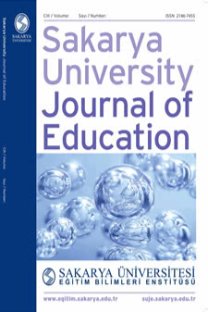Yabancı Dil Öğretimi Sınıflarında Ana Dilinin Yeri
Dil öğretimi sınıflarında; doğrudan öğretici tarafından veya ders materyallerinde ortaya konulan sözlü ve yazılı yönergelerin, öğreticiye yöneltilen sorular veya anlaşılmadığı düşünülen konularda öğretici açıklamalarının ve de öğrenici soruları ile talep ifadelerinin dili olarak birden fazla dil söz konusu olabilir. Bu dilleri üç gruba ayırmak mümkün: hedef dil, araç dil ve ana dili. Dil öğretimi sınıflarında, düzeylere ve dil öğretimi bağlamlarına göre bu dillerin (hedef dil, araç dil ve ana dili) yerinin, sırasının, oranının ne olması gerektiği, öğreticilerin pedagojik muhakeme becerilerinin gelişiminde ve öğretimin yönetiminde temel problematiklerdendir. Makale, bu problematikler içerisinde öğrenicilerin ana dillerinin yerinin ve işlevinin ne olduğu ve ne olması gerektiğini, özellikle öğrenicilerin ana dili bakımından tek dilli sınıflardaki yabancı dil öğretimi bağlamında ele almaktadır. Genel olarak ana dili kullanımına yönelik öğretici tutumlarının, “tamamen yasaklama”, “olabildiğince az yer verme”, “bilinçli olarak belirli durumlarda kullanımını meşrulaştırma” biçiminde olduğu gözlemlenir. Yabancı dil öğretimi sınıflarında öğrenicinin ana dilinin yerini, ortaya konmuş verileri ve görüşleri alanyazın taraması yoluyla belirleyerek ele alan makale, “Ana dili; eğer hedef dilin önceliğini tehdit ediyorsa, yabancı dil sınıfında 'en büyük tehlike' olabilirken; diğer taraftan, ‘sistemli, seçici ve makul dozlarda' kullanılabilirse de 'yabancı bir dilin sahip olabileceği en önemli müttefik’ olabilir.” tezini savunmaktadır.
Anahtar Kelimeler:
Dil öğretimi, yabancı dil öğretimi, ana dili, tek dilli sınıflarda dil öğretimi
The Role of L1 in Foreign Language Teaching Classrooms
In the language teaching classes; there may be more than one language as the language of verbal and written instructions, introduced by the instructor or through course materials, the questions directed to the instructor or the explanations of the instructor about subjects which are not understood, or about learner questions and statements. It is possible to divide these languages into three groups: target language, medium of instruction, and native language. In language teaching classrooms, determining the place, the order and the ratio of these languages (target language, medium of instruction, and native language) according to levels and language teaching contexts is one of the basic problematics in the development of pedagogical reasoning skills of instructors and management of teaching. This paper discusses, the place and function of the native language of the learners and what they should be, especially in the context of foreign language teaching among these problematics. In general, it is observed that instructional attitudes towards the use of native language are “complete prohibition”, “allowed as little as possible”, “consciously legitimize the use of certain situations”. This paper focuses on the role of native language of learner in foreign language teaching classrooms, presented data and views by means of literature review and supports the idea, “Native language; if threatens the priority of target language can be ‘the single biggest threat’ in foreign language class on the other hand, if it can be used in ‘systematic, selective and reasonable doses’ it can be ‘the most important ally a foreign language can have’.”
Keywords:
Language teaching, foreign language teaching, native language / L1, language teaching in monolingual classrooms,
___
- Atkinson, D. (1987). The mother-tongue in the classroom: a neglected resource?. ELT Journal, 41, 4, 241-247.
- Butzkamm, W. (2003). We only learn language once. The role of the mother tongue in FL classrooms: Death of a dogma. Language Learning Journal, 28.1, 29–39.
- Butzkamm, W. (2017). Monolingual principle. M. Byram ve A. Hu (Ed.). Routledge Encyclopedia of Language Teaching and Learning. (ss. 471-474). Routledge Taylor and Francis Group.
- Cook, V. (1999). Going beyond the native speaker in language teaching Author. TESOL Quarterly, Vol. 33, No. 2. pp. 185-209.
- Cook, V. (2001). Using the first language in the classroom. The Canadian Modern Language Review, 57,3, 402-423.
- Dodson, C. J. (1972). Language teaching and the bilingual method. Pitman.
- Eldridge, J. (1996). Code-switching in a Turkish secondary school. ELT Journal, 50(4), 303-311.
- Holthouse, J. (2006). The role of the mother tongue in EFL classrooms. Gaikokugokyoiku Forum, 5, 27-37.
- Littlewood, W. ve Yu, B. (2009). First language and target language in the foreign language classroom. Language Teaching, 44 (1), 64-77.
- Macaro, E. (2001). Analysing student teachers’ codeswitching in foreign language classrooms: Theories and Decision Making. The Modern Language Journal, 85. 531-548.
- Macaro, E.; Tien, L. ve Chu, L. (2018). First and second language use in English medium instruction context. Language Teaching Research, 1-21.
- Richards, J. C. ve Schmidt, R. (2002). Longman dictionary of language teaching & applied linguistics, Longman.
- Şener, S. ve Korkut, P. (2017). Teacher trainees’ awareness regarding mother tongue use in English as a foreign language classes. Journal of Language and Linguistic Studies, 13(1), 41-61.
- Thompson, L. (2017). Mother tongue. M. Byram ve A. Hu (Ed.). Routledge encyclopedia of language teaching and learning. (ss. 474-476). Routledge Taylor Francis Group.
- Turnbull, M. ve Arnett, K. (2002). Teachers’ uses of the target and first languages in second and foreign language classrooms. Annual Review of Applied Linguistics, 22(1) 204-218.
- ISSN: 2146-7455
- Yayın Aralığı: Yılda 3 Sayı
- Başlangıç: 2011
- Yayıncı: Sakarya Üniversitesi Eğitim Bilimleri Enstitüsü
Sayıdaki Diğer Makaleler
Kamil UYGUN, Mehmet Akif KARALI
Yabancı Dil Öğretmenlerinin Değerlendirme Okuryazarlığının İncelenmesi
Emine PEHLİVAN ŞİŞMAN, Kağan BÜYÜKKARCI
Kamil UYGUN, Mehmet Akif KARALI
Türkiye’de Mesleki ve Teknik Ortaöğretimin Gelişimi
Subhan EKŞİOĞLU, Mehmet TAŞPINAR
Recep ÖZ, Mehmet YAZICI, Murat Tolga KAYALAR, Yasemin ÇAKMAK YILDIZHAN
Öğretmenlerin Öznel İyi Oluşları İle Mesleki Dayanıklılıkları Arasındaki İlişkinin İncelenmesi
An Investigation of Pre-Service and In-Service Teachers’ Perceptions of Teacher Quality in Turkey
